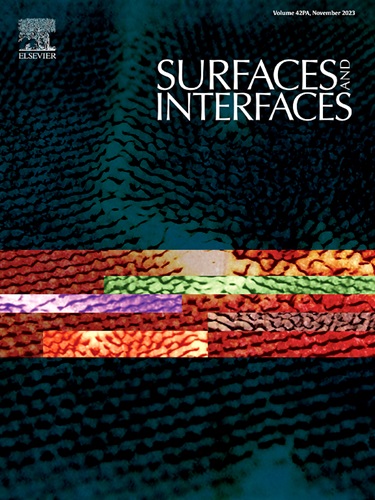Close atomic surface of stainless steel produced by developed novel green chemical mechanical polishing using silica and Samaria composite abrasives
IF 5.7
2区 材料科学
Q2 CHEMISTRY, PHYSICAL
引用次数: 0
Abstract
Stainless steel is a kind of difficult-to-machine material, because of its work hardening and corrosion resistance. Strong acids, alkalis and toxic substances are often employed in traditional chemical mechanical polishing (CMP), leading to the potential pollution to environment. Even that, surface roughness after conventional CMP on a stainless steel is generally higher than 0.7 nm. This does not satisfy the demand for close atomic surface by high-performance devices. To solve these challenges, a novel green CMP was developed, containing silica, samaria, hydrogen peroxide, malic acid and alanine. After CMP, surface roughness Sa of 0.238 nm is achieved on a stainless steel of 12Cr12Mo at a scanning area of 50 × 50 μm2, and material removal rate is 75.26 nm/min. Zeta potential and corrosion current of silica, samaria, and their composite abrasives are -31 mV and 0.708 μA/cm2, 17.2 mV and 0.208 μA/cm2, and -46.2 mV and 1.935 μA/cm2, respectively, indicating the best of composite abrasives for both dispersity and exchange rate of ions among three kinds of ones. Corrosion current of solely malic acid and hydrogen peroxide are 5.127 and 0.249 μA/cm2, respectively, while it increased to 9.05 μA/cm2 when mixing them together, displaying the synergistic effect between them. After inpouring alanine in the mixed solution, corrosion current decreased to 5.713 μA/cm2, showing the inhibition influence on corrosion. X-ray photoelectron spectroscopy demonstrates that hydroxy peroxide oxidized the surface of stainless steel, forming metal oxides. FeO and Fe3O4 were dissolved and chelated by malic acid. Fourier transform infrared spectroscopy reveals that hydroxy and carboxylic functional groups chelated with metal ions, and chelating formulas are proposed. Our developed green CMP paved a new way to garner close atomic surface on a stainless steel with work hardening and corrosion resistance.

求助全文
约1分钟内获得全文
求助全文
来源期刊

Surfaces and Interfaces
Chemistry-General Chemistry
CiteScore
8.50
自引率
6.50%
发文量
753
审稿时长
35 days
期刊介绍:
The aim of the journal is to provide a respectful outlet for ''sound science'' papers in all research areas on surfaces and interfaces. We define sound science papers as papers that describe new and well-executed research, but that do not necessarily provide brand new insights or are merely a description of research results.
Surfaces and Interfaces publishes research papers in all fields of surface science which may not always find the right home on first submission to our Elsevier sister journals (Applied Surface, Surface and Coatings Technology, Thin Solid Films)
 求助内容:
求助内容: 应助结果提醒方式:
应助结果提醒方式:


